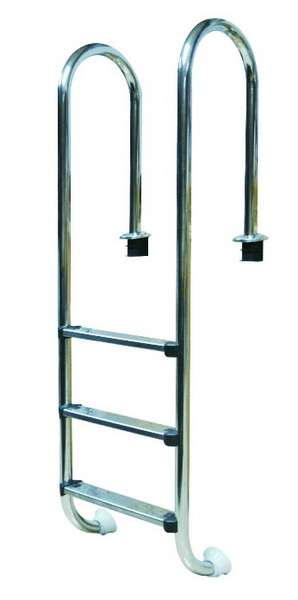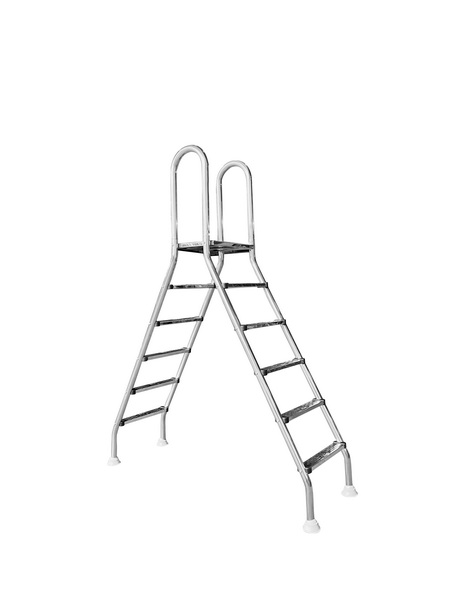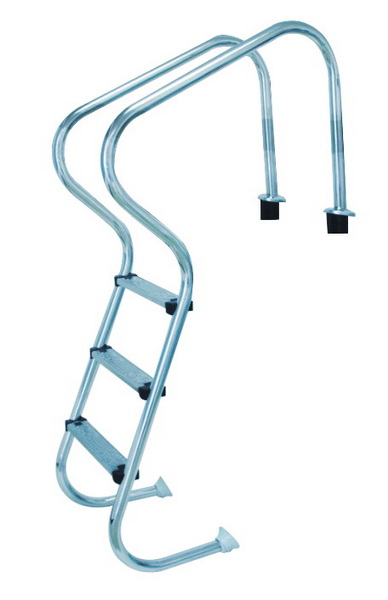







Content Menu
● Importance of Proper Pool Ladder Anchoring
● Step-by-Step Guide to Anchoring an Above-Ground Pool Ladder
● Anchoring Inground Pool Ladders
● Maintenance Tips for Pool Ladder Anchors
● Recommended Ladder Anchor Types
● Frequently Asked Questions (FAQ)
>> 1. How deep should pool ladder anchors be installed?
>> 2. Can I anchor a ladder myself without professional help?
>> 3. What materials are best for pool ladder anchors?
>> 4. How often should ladder anchors be checked?
>> 5. Can ladder anchors be removed or replaced?
Anchoring a pool ladder securely is essential for safe and easy access to your swimming pool. Whether you have an above-ground or inground pool, a well-anchored ladder prevents wobbling, slipping, or accidents. This comprehensive guide will walk you through the steps on how to properly anchor your pool ladder using best practices and compatible hardware.

A pool ladder must be firmly fixed in place for several important reasons. Primarily, secure anchoring ensures user safety by preventing any movement or instability when climbing in and out of the pool. Unstable ladders risk tipping or collapse, which can cause injuries. Proper anchoring also extends the lifespan of your ladder by reducing wear from unnecessary movement and stress on the mounting components. Additionally, a securely anchored ladder maintains the pool area's neat appearance without unsightly tilting or loosening over time.
Before discussing anchoring methods, it helps to understand the main types of pool ladders:
- Above-Ground Pool Ladders: Specially designed for pools with walls above ground level, usually detachable and portable. These ladders often come with platforms or steps on both sides of the pool wall.
- Inground Pool Ladders: Permanently fixed ladders installed into concrete decks or pool coping, usually made of stainless steel with anchor sockets embedded in the pool deck.
Each type requires a slightly different anchoring approach due to their construction and pool setting.
To anchor a pool ladder effectively, gather the following tools and materials:
- Ladder anchor kits or mounting brackets (usually supplied with the ladder)
- Drill with appropriate bits for concrete or pool wall material
- Screwdrivers and wrenches
- Stainless steel bolts, screws, washers, and nuts
- Epoxy or waterproof adhesive (for some installations)
- Measuring tape and level
- Safety goggles and gloves
Having all necessary equipment ready before starting ensures a smooth installation process.

1. Position the Ladder
Place the ladder on the pool edge where you want permanent installation. Ensure the ladder's feet rest firmly on the ground and the top rails align evenly with the pool rim.
2. Mark Anchor Points
Using a pencil or marker, mark drilling spots through the ladder's mounting holes onto the pool deck or platform.
3. Pre-Drill Holes
Wear safety goggles and drill pilot holes at marked spots using a drill bit designed for the pool deck material (concrete, wood, or composite).
4. Install Anchors or Brackets
Insert anchors into drilled holes. If using epoxy for added strength, inject it before placing anchors and allow it to cure fully.
5. Secure the Ladder
Fix the ladder onto the anchors with stainless steel bolts and washers. Tighten bolts evenly to avoid ladder deformation or misalignment.
6. Test Stability
Gently shake the ladder to check stability. Make adjustments if necessary to eliminate any lateral movement.
7. Optional Steps
For additional safety, use pool ladder stabilizers or anti-slip pads on ladder feet to enhance grip around the pool.
For inground ladders, the anchoring process has some differences:
- Embedded Sockets: Installation starts with hydraulic or concrete anchor sockets embedded into the pool deck during or after pool construction.
- Insert Ladder Rails: Ladder handrails have lower ends designed to slide securely into these sockets.
- Bolt In Place: Use provided bolts and fasteners to lock ladder rails firmly into anchors.
- Sealing Edges: Apply silicone sealant at the junction of the ladder and pool deck to prevent water infiltration and corrosion.
Proper maintenance prolongs ladder and anchor life:
- Periodically check bolts and screws for tightness.
- Clean ladder and anchor components to remove rust or calcium deposits.
- Lubricate moving parts, if any, with pool-safe lubricants.
- Replace damaged anchors or corroded bolts immediately.
- Always use corrosion-resistant stainless-steel hardware in pool environments.
- Make sure electric drilling tools are rated for outdoor use and have proper insulation.
- Keep children away during installation.
- Follow all manufacturer guidelines specific to your ladder model.
- Surface Mount Anchors: Bolted directly to the pool deck surface, ideal for repair or retrofit jobs.
- Embed Anchors: Installed during pool deck construction, offering the most durable hold.
- Deck-Mounted Flanges: Provide extra stability with a flange that covers a larger deck area.
Properly anchoring a pool ladder is critical for user safety and ladder longevity. By following the step-by-step instructions tailored for above-ground or inground pools, using the right tools, and maintaining hardware regularly, your pool ladder will remain stable and secure for years. Remember always to prioritize safety during installation and choose anchor types compatible with your pool configuration.

Anchors typically need to be embedded at least 3-4 inches into concrete or deck material to ensure stability.
Yes, with proper tools and instructions, most pool owners can safely anchor ladders themselves.
Stainless steel is highly recommended for corrosion resistance in wet pool environments.
It's best to inspect ladder anchors monthly, especially at the start of each swimming season.
Yes, most anchors can be removed and replaced if damaged or worn, using appropriate tools and replacement parts.
